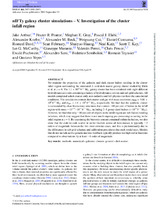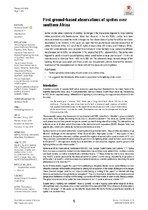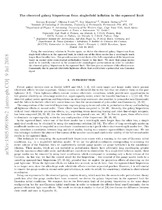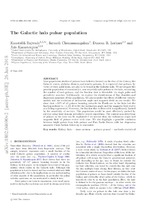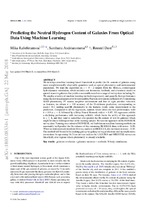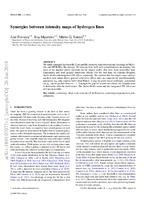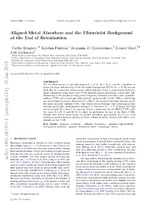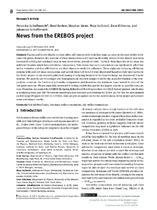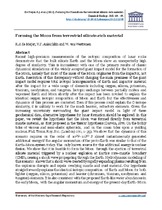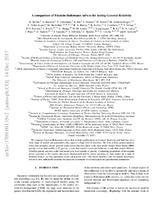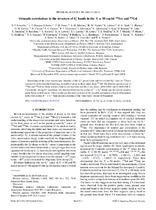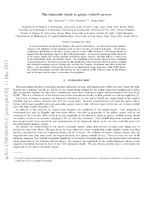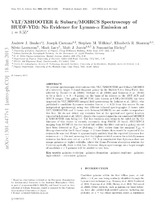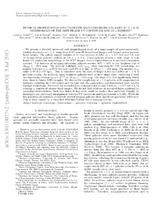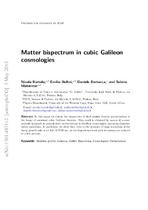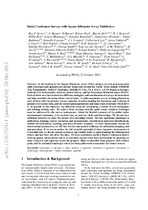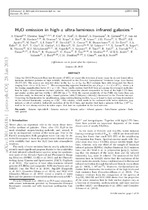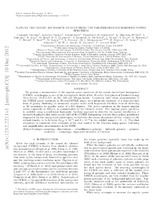Research Articles (Physics): Recent submissions
Now showing items 421-440 of 520
-
nIFTy galaxy cluster simulations – V. Investigation of the cluster infall region
(Oxford University Press, 2016)We examine the properties of the galaxies and dark matter haloes residing in the cluster infall region surrounding the simulated cold dark matter galaxy cluster studied by Elahi et al. at z = 0. The 1.1 × 1015 h−1M ... -
First ground-based observations of sprites over southern Africa
(Academy of Science of South Africa, 2018)Sprites are the optical signatures of electrical discharges in the mesosphere triggered by large lightning strikes associated with thunderstorms. Since their discovery in the late 1980s, sprites have been observed ... -
The observed galaxy bispectrum from single-field inflation in the squeezed limit
(IOP Publishing, 2018)Using the consistency relation in Fourier space, we derive the observed galaxy bispectrum from single- eld in ation in the squeezed limit, in which one of the three modes has a wavelength much longer than the other two. ... -
The Galactic halo pulsar population
(Oxford University Press, 2018)Most population studies of pulsars have hitherto focused on the disc of the Galaxy, the Galactic centre, globular clusters, and nearby galaxies. It is expected that pulsars, by virtue of their natal kicks, are also to ... -
Predicting the neutral hydrogen content of galaxies from optical data using machine learning
(Oxford University Press, 2018)We develop a machine learning-based framework to predict the Hi content of galaxies using more straightforwardly observable quantities such as optical photometry and environmental parameters. We train the algorithm on z ... -
Synergies between intensity maps of hydrogen lines
(Oxford University Press, 2018)We study synergies between Hi 21cm and Hα intensity map observations, focusing on SKA1- like and SPHEREx-like surveys. We forecast how well such a combination can measure features in the angular power spectrum on the ... -
Aligned metal absorbers and the ultraviolet background at the end of reionization
(Oxford University Press, 2018)We use observations of spatially-aligned C ii, C iv, Si ii, Si iv, and O i absorbers to probe the slope and intensity of the ultraviolet background (UVB) at z ∼ 6. We accom- plish this by comparing observations with ... -
News from the EREBOS project
(De Gruyter Open, 2017)Planets and brown dwarfs in close orbits will interact with their host stars, as soon as the stars evolve to become red giants. However, the outcome of those interactions is still unclear. Recently, several brown dwarfs ... -
Forming the Moon from terrestrial silicate-rich material
(Elsevier, 2013)Recent high-precision measurements of the isotopic composition of lunar rocks demonstrate that the bulk silicate Earth and the Moon show an unexpectedly high degree of similarity. This is inconsistent with one of the ... -
Visible and IR photoluminescence of c-FeSi@a–Si core–shell nano-fibres produced by vapour transport
(Elsevier, 2013)The procedures for the synthesis of amorphous ε-FeSi/Sicore–shell nanofibres by vapour transport in a CVD configuration are reported. Crystallite studies by the Williamson-Hall method show the sizes to be typically about ... -
Characterization of silicon nitride thin films deposited by hot-wire CVD at low gas flow rates
(Elsevier, 2013)We examined the chemical, structural, mechanical and optical properties of amorphous hydrogenatedsilicon nitride thin films deposited by hot-wire chemical vapour deposition using SiH4, NH3and H2gases at total flow rates ... -
A comparison of Einstein-Boltzmann solvers for testing General Relativity
(American Physical Society, 2018)We compare Einstein-Boltzmann solvers that include modifications to General Relativity and find that, for a wide range of models and parameters, they agree to a high level of precision. We look at three general purpose codes ... -
Octupole correlations in the structure of O2 bands in the N=88 nuclei150Sm Gd
(American Physical Society, 2013)Knowledge of the exact microscopic structure of the 01 + ground state and first excited 02 + state in 150Sm is required to understand the branching of double β decay to these states from 150Nd. The detailed spectroscopy ... -
The kinematic dipole in galaxy redshift surveys
(IOP Publishing, 2018)In the concordance model of the Universe, the matter distribution { as observed in galaxy number counts or the intensity of line emission (such as the 21cm line of neutral hydrogen) - should have a kinematic dipole due ... -
VLT/XSHOOTER & Subaru/MOIRCS spectroscopy of HUDF-YD3: No evidence for Lyman-alpha emission at z=8.55
(Oxford University Press, 2013)We present spectroscopic observations with VLT/XSHOOTER and Subaru/MOIRCS of a relatively bright Y -band drop-out galaxy in the Hubble Ultra Deep Field, first selected by Bunker et al. (2010), McLure et al. (2010) and ... -
Physical properties of spectroscopically-confirmed galaxies at z >= 6. II. Morphology of the rest-frame UV continuum and Lyman-alpha emission
(IOP Science, 2013)We present a detailed structural and morphological study of a large sample of spectroscopicallyconfirmed galaxies at z ≥ 6, using deep HST near-IR broad-band images and Subaru optical narrowband images. The galaxy sample ... -
Matter bispectrum in cubic Galileon cosmologies
(IOP Science, 2013)In this paper we obtain the bispectrum of dark matter density perturbations in the frame of covariant cubic Galileon theories. This result is obtained by means of a semi- analytic approach to second-order perturbations ... -
Radio continuum surveys with square kilometre array pathfinders
(Cambridge University Press, 2013)In the lead-up to the Square Kilometre Array (SKA) project, several next-generation radio telescopes and upgrades are already being built around the world. These include APERTIF (The Netherlands), ASKAP (Australia), ... -
H2O emission in high-z ultra-luminous infrared galaxies
(edp sciences, 2013)Using the IRAM Plateau de Bure interferometer (PdBI), we report the detection of water vapor in six new lensed ultraluminous starburst galaxies at high redshift, discovered in the Herschel Astrophysical Terahertz Large ... -
H-Atlas: The cosmic abundance of dust from the far-infrared background power spectrum
(IOP Science, 2013)We present a measurement of the angular power spectrum of the cosmic far-infrared background (CFIRB) anisotropies in one of the extragalactic fields of the Herschel Astrophysical Terahertz Large Area Survey (H-ATLAS) at ...

